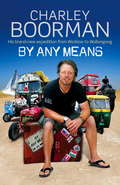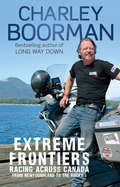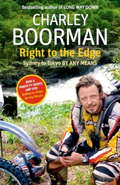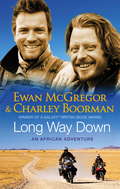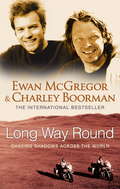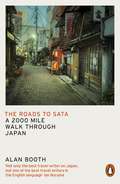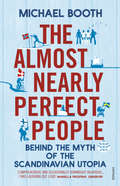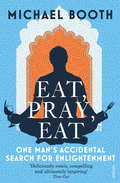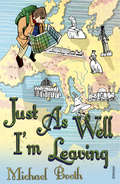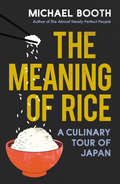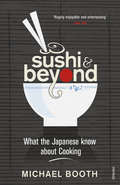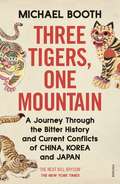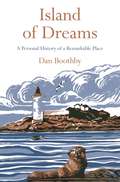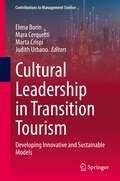- Table View
- List View
Fishing smack, 1882 AD (Large Print)
by Rnib BookshareThis image shows a side view of an old fishing boat in full sail at sea. There is a locator dot shown, which will be at the top left when the image is the correct way up. An image border surrounds the image. The front of the boat (bow) is on the left and the back (stern) is on the right of the page. In the top centre of the image, is the top of the mast with a flag to the right. Moving down the upper mast there is a triangular topsail to the right. The upper mast is joined to the main mast at the bottom corner of the topsail. Going up and right from here is the gaff boom (a pole). The main gaff sail hangs from it. Down and to the left of the main mast are two triangular foresails. The one to the left has its bottom edge attached to a bowsprit which is a pole sticking out forwards horizontally. To the right the bottom edge of the main gaffsail is attached to the main boom, another horizontal pole. The sail covers part of the boom to the left. Down from the left part of the gaffsail is the top of a small cabin. To the right of the main mast is the mizzen mast. It has a small gaff sail to the right and a long thin flag at the top. At the very end of the boat, a small tender (dingy) hangs facing away so only the stern end of it can be found. The hull of the main boat is at the bottom of the image. It is moving to the left through choppy water so not all the hull can be found.
Fishing smack, 1882 AD (UEB Contracted)
by Rnib BookshareThis image shows a side view of an old fishing boat in full sail at sea. There is a locator dot shown, which will be at the top left when the image is the correct way up. An image border surrounds the image. The front of the boat (bow) is on the left and the back (stern) is on the right of the page. In the top centre of the image, is the top of the mast with a flag to the right. Moving down the upper mast there is a triangular topsail to the right. The upper mast is joined to the main mast at the bottom corner of the topsail. Going up and right from here is the gaff boom (a pole). The main gaff sail hangs from it. Down and to the left of the main mast are two triangular foresails. The one to the left has its bottom edge attached to a bowsprit which is a pole sticking out forwards horizontally. To the right the bottom edge of the main gaffsail is attached to the main boom, another horizontal pole. The sail covers part of the boom to the left. Down from the left part of the gaffsail is the top of a small cabin. To the right of the main mast is the mizzen mast. It has a small gaff sail to the right and a long thin flag at the top. At the very end of the boat, a small tender (dingy) hangs facing away so only the stern end of it can be found. The hull of the main boat is at the bottom of the image. It is moving to the left through choppy water so not all the hull can be found.
Fishing smack, 1882 AD (UEB Uncontracted)
by Rnib BookshareThis image shows a side view of an old fishing boat in full sail at sea. There is a locator dot shown, which will be at the top left when the image is the correct way up. An image border surrounds the image. The front of the boat (bow) is on the left and the back (stern) is on the right of the page. In the top centre of the image, is the top of the mast with a flag to the right. Moving down the upper mast there is a triangular topsail to the right. The upper mast is joined to the main mast at the bottom corner of the topsail. Going up and right from here is the gaff boom (a pole). The main gaff sail hangs from it. Down and to the left of the main mast are two triangular foresails. The one to the left has its bottom edge attached to a bowsprit which is a pole sticking out forwards horizontally. To the right the bottom edge of the main gaffsail is attached to the main boom, another horizontal pole. The sail covers part of the boom to the left. Down from the left part of the gaffsail is the top of a small cabin. To the right of the main mast is the mizzen mast. It has a small gaff sail to the right and a long thin flag at the top. At the very end of the boat, a small tender (dingy) hangs facing away so only the stern end of it can be found. The hull of the main boat is at the bottom of the image. It is moving to the left through choppy water so not all the hull can be found.
Lorry (UEB uncontracted)
by Rnib BookshareThis lorry is shown from the side. There is a locator dot shown, which will be at the top left of the page when the image is the right way up. `The front of the lorry is on the left of the page, and the rear of the lorry is on the right. The driver's cab, at the front of the lorry, has a small bumper sticking out in the bottom. The cab is mainly taken up by a door, which has a window and a door handle. Behind the driver's cab is the large, enclosed trailer. In the middle, there is a long rectangular panel on which a company sign or advert can be displayed. Underneath the lorry three wheels are shown - one under the cab and the others under the trailer.
Mountain Rescue Land Rover (Large Print)
by Rnib BookshareThe Land Rover is viewed from the side with only two of its four wheels showing at the bottom of the page. There is a locator dot shown, which will be at the top left of the page when the image is the right way up.The front of the Land Rover is on the left of the page and the rear on the right. There is a winch sticking out just above and to the left of the front wheel. Up and right from this is an extra headlight. The emergency vehicle reflective strip runs the entire length of the vehicle from here. In the centre of the image are two of the Land Rover's doors. The front door to the left has a mirror in the bottom left corner of its window. The door handles are near the bottom right corner of each window. Up from the front door is a large spotlight on the front corner of the roof, and to the right of this is the blue emergency light on a small raised block. To the right of this is the aerial and then a large roof rack for equipment. On the far right of the vehicle is the rear light.
Mountain Rescue Land Rover (UEB Contracted)
by Rnib BookshareThe Land Rover is viewed from the side with only two of its four wheels showing at the bottom of the page. There is a locator dot shown, which will be at the top left of the page when the image is the right way up.The front of the Land Rover is on the left of the page and the rear on the right. There is a winch sticking out just above and to the left of the front wheel. Up and right from this is an extra headlight. The emergency vehicle reflective strip runs the entire length of the vehicle from here. In the centre of the image are two of the Land Rover's doors. The front door to the left has a mirror in the bottom left corner of its window. The door handles are near the bottom right corner of each window. Up from the front door is a large spotlight on the front corner of the roof, and to the right of this is the blue emergency light on a small raised block. To the right of this is the aerial and then a large roof rack for equipment. On the far right of the vehicle is the rear light.
Mountain Rescue Land Rover (UEB uncontracted)
by Rnib BookshareThe Land Rover is viewed from the side with only two of its four wheels showing at the bottom of the page. There is a locator dot shown, which will be at the top left of the page when the image is the right way up.The front of the Land Rover is on the left of the page and the rear on the right. There is a winch sticking out just above and to the left of the front wheel. Up and right from this is an extra headlight. The emergency vehicle reflective strip runs the entire length of the vehicle from here. In the centre of the image are two of the Land Rover's doors. The front door to the left has a mirror in the bottom left corner of its window. The door handles are near the bottom right corner of each window. Up from the front door is a large spotlight on the front corner of the roof, and to the right of this is the blue emergency light on a small raised block. To the right of this is the aerial and then a large roof rack for equipment. On the far right of the vehicle is the rear light.
Police Car (UEB Contracted)
by Rnib BookshareThe police car is seen from the side, with only two of its four wheels showing at the bottom of the page. There is a locator dot shown, which will be at the top left of the page when the image is the right way up. The front (bonnet) of the car is at the left, and the rear (boot) at the right. The bumpers stick out slightly at the lower front and rear of the car. Above the front bumper is one headlight. Just to the right and slightly below this, the emergency vehicle reflective strip runs the length of the car, with one of the tail lights just above and to the right of it at the top of the boot. In the centre of the image, to the left is one front door and one rear door to the right. Each has a door handle just above the reflective strip, with a window above that. The wing mirror is shown at the lower left of the front window. At the top of the image, the blue emergency light is in the middle of the car's roof, with a tall aerial to its right.
Police Car (UEB uncontracted)
by Rnib BookshareThe police car is seen from the side, with only two of its four wheels showing at the bottom of the page. There is a locator dot shown, which will be at the top left of the page when the image is the right way up. The front (bonnet) of the car is at the left, and the rear (boot) at the right. The bumpers stick out slightly at the lower front and rear of the car. Above the front bumper is one headlight. Just to the right and slightly below this, the emergency vehicle reflective strip runs the length of the car, with one of the tail lights just above and to the right of it at the top of the boot. In the centre of the image, to the left is one front door and one rear door to the right. Each has a door handle just above the reflective strip, with a window above that. The wing mirror is shown at the lower left of the front window. At the top of the image, the blue emergency light is in the middle of the car's roof, with a tall aerial to its right.
By Any Means: His Brand New Adventure From Wicklow to Wollongong
by Charley BoormanFour million captivated viewers watched Charley Boorman complete his last adventure - LONG WAY DOWN - which took him from John O'Groats to Cape Town. Along with Ewan McGregor he achieved not only this amazing feat, but also circumnavigated the globe on the LONG WAY ROUND. In between these two incredible journeys, he found the time to compete in the Dakar Rally, telling his story in his bestselling book RACE TO DAKAR. Charley's passion for travel and adventure continues in his new challenge - BY ANY MEANS. Travelling from his home town in Co Wicklow all the way to Sydney, he will use any means he can to reach his destination, via transport as diverse as steam train, horse, boat, kayak, truck, and tuk-tuk. And of course his beloved motorbike! Whether crossing the Black Sea, trekking through Tibet, riding an elephant in India or hiking through the forests of Papua New Guinea, this will be a unique opportunity to meet fascinating people and explore extraordinary places. With trademark enthusiasm, dedication and good humour, Charley's new trip is set to be his most challenging yet.
Extreme Frontiers: Racing Across Canada from Newfoundland to the Rockies
by Charley BoormanCharley Boorman is back on his bike exploring the world's second largest country - home to some of the most stunning and challenging terrain known to man. Canada is a country of extremes, and Charley knows all about pushing the limits. He goes dirt biking in New Brunswick, dives through old shipwrecks in Tobermory and rides along Butch Cassidy's old Outlaw Trail. He also meets a fascinating mix of people on his journey. As he heads across Canada, he plays ice hockey with a legend of the game; spends a day as a Mountie cadet and nearly meets a ghost in Winnipeg . . . Written with Charley's trademark enthusiasm and humour, Extreme Frontiers is fast-paced, hugely entertaining and packed with adventure (and rather a lot of mosquitoes).
Right To The Edge: The Road to the End of the Earth
by Charley BoormanFour million captivated viewers watched Charley Boorman complete his last adventure - LONG WAY DOWN - which took him from John O'Groats to Cape Town. Along with Ewan McGregor he achieved not only this amazing feat, but also circumnavigated the globe on the LONG WAY ROUND. In between these two incredible journeys, he found the time to compete in the Dakar Rally, telling his story in his bestselling book RACE TO DAKAR. Charley's passion for travel and adventure continues in his new challenge - BY ANY MEANS. Travelling from his home town in Co Wicklow all the way to Sydney, he will use any means he can to reach his destination, via transport as diverse as steam train, horse, boat, kayak, truck, and tuk-tuk. And of course his beloved motorbike! Whether crossing the Black Sea, trekking through Tibet, riding an elephant in India or hiking through the forests of Papua New Guinea, this will be a unique opportunity to meet fascinating people and explore extraordinary places. With trademark enthusiasm, dedication and good humour, Charley's new trip is set to be his most challenging yet.
Long Way Down: An Epic Journey By Motorcycle From Scotland To South Africa
by Charley Boorman Ewan McGregorAfter their fantastic trip round the world in 2004, fellow actors and bike fanatics Ewan McGregor and Charley Boorman couldn't shake the travel bug. And after an inspirational UNICEF visit to Africa, they knew they had to go back and experience this extraordinary continent in more depth. And so they set off on their 15,000-mile journey with two new BMWs loaded up for the trip. Joining up with producer/directors Russ Malkin and David Alexanian and the Long Way Round team, their route took them from John O'Groats at the northernmost tip of Scotland to Cape Agulhas on the southernmost tip of South Africa. Riding through spectacular scenery, often in extreme temperatures, Ewan and Charley faced their hardest challenges yet. With their trademark humour and honesty they tell their story - the drama, the dangers and the sheer exhilaration of riding together again, through a continent filled with magic and wonder.
Long Way Round: Chasing Shadows Across The World
by Charley Boorman Ewan McGregor'A highly readable and spiritually uplifting book about a dream come true' Wanderlust 'Touching and memorable ... one for armchair travellers and bike freaks' Daily MailFrom London to New York, Ewan and Charley chased their shadows through Europe, the Ukraine, Kazakhstan, Mongolia and Russia, across the Pacific to Alaska, then down through Canada and America. But as the miles slipped beneath the tyres of their big BMWs, their troubles started. Exhaustion, injury and accidents tested their strength. Treacherous roads, unpredictable weather and turbulent politics challenged their stamina. They were chased by paparazzi in Kazakhstan, courted by men with very large guns in the Ukraine, hassled by the police, and given bulls' testicles for supper by Mongolian nomads. And yet despite all these obstacles they managed to ride more than twenty thousand miles in four months, changing their lives forever in the process. As they travelled they documented their trip, taking photographs, and writing diaries by the campfire. Long Way Round is the result of their adventures - a fascinating, frank and highly entertaining travel book about two friends riding round the world together and, against all the odds, realising their dream.
The Routledge Companion to William Morris (Routledge Art History and Visual Studies Companions)
by Florence S. BoosWilliam Morris (1834–96) was an English poet, decorative artist, translator, romance writer, book designer, preservationist, socialist theorist, and political activist, whose admirers have been drawn to the sheer intensity of his artistic endeavors and efforts to live up to radical ideals of social justice. This Companion draws together historical and critical responses to the impressive range of Morris’s multi-faceted life and activities: his homes, travels, family, business practices, decorative artwork, poetry, fantasy romances, translations, political activism, eco-socialism, and book collecting and design. Each chapter provides valuable historical and literary background information, reviews relevant opinions on its subject from the late-nineteenth century to the present, and offers new approaches to important aspects of its topic. Morris’s eclectic methodology and the perennial relevance of his insights and practice make this an essential handbook for those interested in art history, poetry, translation, literature, book design, environmentalism, political activism, and Victorian and utopian studies.
The Routledge Companion to William Morris (Routledge Art History and Visual Studies Companions)
by Florence S. BoosWilliam Morris (1834–96) was an English poet, decorative artist, translator, romance writer, book designer, preservationist, socialist theorist, and political activist, whose admirers have been drawn to the sheer intensity of his artistic endeavors and efforts to live up to radical ideals of social justice. This Companion draws together historical and critical responses to the impressive range of Morris’s multi-faceted life and activities: his homes, travels, family, business practices, decorative artwork, poetry, fantasy romances, translations, political activism, eco-socialism, and book collecting and design. Each chapter provides valuable historical and literary background information, reviews relevant opinions on its subject from the late-nineteenth century to the present, and offers new approaches to important aspects of its topic. Morris’s eclectic methodology and the perennial relevance of his insights and practice make this an essential handbook for those interested in art history, poetry, translation, literature, book design, environmentalism, political activism, and Victorian and utopian studies.
The Roads to Sata: A 2000-mile walk through Japan
by Alan Booth'A memorable, oddly beautiful book' Wall Street Journal'A marvellous glimpse of the Japan that rarely peeks through the country's public image' Washington PostOne sunny spring morning in the 1970s, an unlikely Englishman set out on a pilgrimage that would take him across the entire length of Japan. Travelling only along small back roads, Alan Booth travelled on foot from Soya, the country's northernmost tip, to Sata in the extreme south, traversing three islands and some 2,000 miles of rural Japan. His mission: 'to come to grips with the business of living here,' after having spent most of his adult life in Tokyo.The Roads to Sata is a wry, witty, inimitable account of that prodigious trek, vividly revealing the reality of life in off-the-tourist-track Japan. Journeying alongside Booth, we encounter the wide variety of people who inhabit the Japanese countryside - from fishermen and soldiers, to bar hostesses and school teachers, to hermits, drunks and the homeless. We glimpse vast stretches of coastline and rambling townscapes, mountains and motorways; watch baseball games and sunrises; sample trout and Kilamanjaro beer, hear folklore, poems and smutty jokes. Throughout, we enjoy the wit and insight of a uniquely perceptive guide, and more importantly, discover a new face of an often-misunderstood nation.
The Almost Nearly Perfect People: Behind the Myth of the Scandinavian Utopia
by Michael BoothThe Danes are the happiest people in the world, and pay the highest taxes.'Neutral' Sweden is one of the biggest arms manufacturers in the world.Finns have the largest per capita gun ownership after the US and Yemen.54 per cent of Icelanders believe in elves.Norway is the richest country on earth.5 per cent of Danish men have had sex with an animal.Michael Booth has lived among the Scandinavians, on and off, for over ten years, perplexed by their many strange paradoxes and character traits and equally bemused by the unquestioning enthusiasm for all things Nordic and hygge that has engulfed the rest of the world. He leaves his adopted home of Denmark and embarks on a journey through all five of the Nordic countries to discover who these curious tribes are, the secrets of their success and, most intriguing of all, what they think of each other. Along the way a more nuanced, often darker picture emerges of a region plagued by taboos, characterised by suffocating parochialism and populated by extremists of various shades.'The next Bill Bryson.’ New York TimesWinner of the Best Narrative Travel Book Award from the British Guild of Travel Writers
Eat Pray Eat
by Michael Booth'The next Bill Bryson.’ New York TimesWorld-weary, distracted and more often than not the worse for wine, Michael Booth really needed to make some major changes to his life. Instead, he embarks on an over-ambitious, self-indulgent attempt to write the definitive book on Indian food, taking his wife and two young children in tow.They criss-cross India, from mist-shrouded Delhi to Mumbai and the slums of Dharavi, meeting the locals and samplying different cuisines along the way. However, his plan is derailed as he spirals deeper into his metaphysical middle-aged malaise, finally unravelling amid the sweltering heat of the Keralan backwaters.Fortunately, his wife takes control and enrolls her disintegrating husband in a hardcore yoga boot camp, enlisting a wise meditation guru who helps him chart a path towards enlightenment. But will Booth's cynicism and untrammelled appetites prove his undoing? Can he regain his balance, conquer his anxieties and face up to life as a husband and father?
Just As Well I'm Leaving: To the Orient With Hans Christian Andersen
by Michael Booth'The next Bill Bryson.’ New York TimesHaving been dragged against his will to live in Denmark, Michael Booth discovered one of the great secrets of travel literature - Andersen's A Poet's Bazaar - a fascinating travelogue through a Europe on the cusp of revolution, by an author who invented children's literature. He discovered, too, his chance to escape Denmark.In 1840 Andersen was also desperate to flee, writing as he sailed: 'It is just as well I am leaving, my soul is unwell!' In Germany he was enraptured both by steam travel and the fiery Franz Liszt. In sultry Naples this latent bisexual wrestled with his erotic demons before travelling to Athens (little more than a village), seeing the dervishes dance in Istanbul, and sailing home up the Danube. Booth follows him every step of the way, reflecting on Andersen's life, work and pathological self-obsession, encountering his own cast of characters, from an accommodating Hamburg prostitute to a bemused Danish Ambassador to the first ever female dervish, who whisks him off to meet her guru.
The Meaning of Rice: And Other Tales from the Belly of Japan
by Michael Booth**Shortlisted for the 2017 André Simon Food and Drink Book Awards****Shortlisted for the 2018 Fortnum & Mason Food Book Award**'The next Bill Bryson.’ New York TimesIn this often hilarious yet deeply researched book, food and travel writer Michael Booth and his family embark on an epic journey the length of Japan to explore its dazzling food culture. They find a country much altered since their previous visit ten years earlier (which resulted in the award-winning international bestseller Sushi and Beyond). Over the last decade the country’s restaurants have won a record number of Michelin stars and its cuisine was awarded United Nations heritage status. The world’s top chefs now flock to learn more about the extraordinary dedication of Japan’s food artisans, while the country’s fast foods – ramen, sushi and yakitori – have conquered the world. As well as the plaudits, Japan is also facing enormous challenges. Ironically, as Booth discovers, the future of Japan’s culinary heritage is under threat.Often venturing far off the beaten track, the author and his family discover intriguing future food trends and meet a fascinating cast of food heroes, from a couple lavishing love on rotten fish, to a chef who literally sacrificed a limb in pursuit of the ultimate bowl of ramen, and a farmer who has dedicated his life to growing the finest rice in the world… in the shadow of Fukushima. They dine in the greatest restaurant in the world, meet the world champion of cakes, and encounter wild bears. Booth is invited to judge the world sushi championship, ‘enjoys’ the most popular Japanese dish you have never heard of aboard a naval destroyer, and unearths the unlikely story of the Englishwoman who helped save the seaweed industry.Sushi and Beyond was also a bestseller in Japanese where its success has had improbable consequences for Booth and his family. They now star in their own popular cartoon series produced by national broadcaster NHK.
Sushi and Beyond: What the Japanese Know About Cooking
by Michael Booth‘His account of their “foodie family road trip” establishes Booth as the next Bill Bryson.’ New York TimesJapan is the pre-eminent food nation on earth. The creativity of the Japanese, their dedication and ingenuity, not to mention courage in the face of dishes such as cod sperm and octopus ice cream, is only now beginning to be fully appreciated in the sushi-saturated West, as are the remarkable health benefits of the traditional Japanese diet.Food and travel writer Michael Booth sets of to take the culinary pulse of contemporary Japan and he and his young family travel the length of the country - from bear-infested, beer-loving Hokkaido to snake-infested, seaweed-loving Okinawa.What do the Japanese know about food? Perhaps more than anyone else on earth, judging by this fascinating and funny journey through an extraordinary food-obsessed country.Winner of the Guild of Food Writers Kate Whiteman Award for the best book on food and travel.
Three Tigers, One Mountain: A Journey through the Bitter History and Current Conflicts of China, Korea and Japan
by Michael Booth'The next Bill Bryson' (New York Times) explores international relations past and present between three East Asian countries – Japan, South Korea and China – in this lively, absorbing travelogue‘Two tigers cannot share the same mountain’ - Chinese proverb China, Korea and Japan are the neighbours who love to hate each other. But why? Europe has forgiven Germany’s war crimes, why can’t Japan’s neighbours do likewise? To what extent do the ongoing state-level disputes about island ownership, war history, controversial shrines and statues, missile systems and military escalation reflect how the people of these countries regard each other? They have so much to gain from amicable relations, so why do they seem to be doing their level best to keep the fires of hatred burning? The Chinese, Koreans and Japanese are more than neighbours, they are siblings from a Confucian family. They share so much culturally, from this ancient philosophy with its hierarchical, bureaucratic legacy, to rice-growing, art, architecture, chopsticks, noodles and much more which has been passed down from China over millennia. In turn, China has modelled much of its recent industrial and economic strategy on Japan’s post-war manufacturing miracle, and adores contemporary Korean popular culture. Yet still East Asia festers with a mutual animosity which frequently threatens to draw the world into a twenty-first-century war. In his previous international best-seller, The Almost Nearly Perfect People, Michael Booth set out to explore the Scandinavian tribes and what they think of each other. In this new book, which blends popular anthropology, history, politics and travel, the subjects are these Asian tigers that have endured occupation, war and devastation to become among the richest, most developed and powerful societies on Earth. In this deeply researched, revealing book, he sets off on a journey by car, boat, train and plane through all three countries, ending up in a fourth, Taiwan. Here, he hopes to find a positive story but instead discovers the Taiwanese are not merely in conflict with the Chinese, but they also harbour another, less well-known but still bitter grudge towards an East Asian neighbour.
Island of Dreams: A Personal History of a Remarkable Place
by Dan BoothbyDan Boothby had been drifting for more than twenty years, without the pontoons of family, friends or a steady occupation. He was looking for but never finding the perfect place to land. Finally, unexpectedly, an opportunity presented itself. After a lifelong obsession with Gavin Maxwell's Ring of Bright Water trilogy, Boothby was given the chance to move to Maxwell's former home, a tiny island on the western seaboard of the Highlands of Scotland.Island of Dreams is about Boothby's time living there, and about the natural and human history that surrounded him; it's about the people he meets and the stories they tell, and about his engagement with this remote landscape, including the otters that inhabit it. Interspersed with Boothby's own story is a quest to better understand the mysterious Gavin Maxwell.Beautifully written and frequently leavened with a dry wit, Island of Dreams is a charming celebration of the particularities of place.
Cultural Leadership in Transition Tourism: Developing Innovative and Sustainable Models (Contributions to Management Science)
by Elena Borin Mara Cerquetti Marta Crispí Judith UrbanoCultural tourism has proved to be a significant source of economic development for cultural destinations, but it has also emerged as a sometimes potentially controversial and unsustainable phenomenon. The recent pandemic has also pointed out that we need different models of development of tourism, that include a more balanced approach to cultural components in cities and rural areas. Calls have been made on the need to design more sustainable models of tourism development for cultural destinations, conceiving tourism as a means to increasing the quality of life and generating economic opportunities in cities and regions by involving their communities and stakeholders. This book presents an in-depth analysis of the transition towards more sustainable models of cultural tourism development. Starting from the ongoing debate on cultural ecosystems, the book explores the potential key role of cultural and creative organizations as leaders of change. Including theoretical contributions, quantitative and qualitative analyses and international case studies, the book explores the role of cultural actors as leaders and their potential as drivers of culture-led innovation for tourism in cities and regions.

